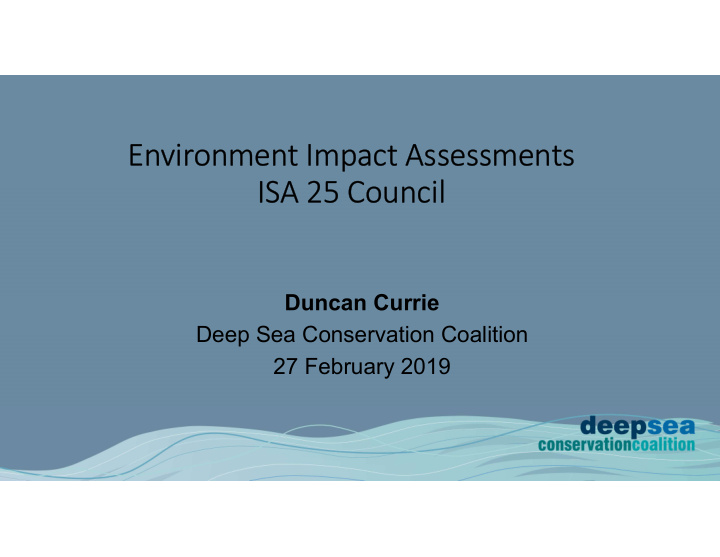



Environment Impact Assessments ISA 25 Council Duncan Currie Deep Sea Conservation Coalition 27 February 2019
• Disturbances or destruction of the benthic layer and organisms living there • Sediment plumes • Increased toxicity of the water column • Pollution (deposition of tailings, Risks & impacts potentially remobilizing toxic chemicals) • Noise and vibration disturbances • Biodiversity loss, and loss of benefits deriving from the destruction of valuable marine genetic resources
EIA Steps Screening Which projects need EIA, level assessment needed Scoping Impacts relevant to assess, alternative solutions, sites, designs Assessment Assessment, evaluation impacts Reporting Technical report + Environmental Management Plan+ Summary Review Public involvement, peer review, independent Decision-Making Precautionary approach, sustainability criteria Monitoring, Compliance, Enforcement, envt’al Auditing 3
Procedural Needs EIA/EIS • Process: clear, transparent, timelines • Including workshops, subcommittees etc • Applications: transparent, comprehensive and fair evaluation • EIAs: independent scientific review, public, comment • Findings translated into EMMPs, etc
Draft Regulations EIAs not provided for EIS: Germany and FSM noted that the current proposed draft regulations lack specific assessment criteria, including quantitative thresholds. DOSI emphasized that objectives and metrics need to be established for the entire Area as well as regionally and at the project level. • Japan, DSCC, DOSI recommended scoping be reinstated (UK asked too) • DSCC stressed that scoping and EIA processes should be iterative to ensure all necessary information is collected. • FSM stated that the status of EISs remains unclear and suggested cross-referencing EISs and EMMPs throughout the regulations to highlight them as “core components” of environmental protection
Draft Regulations EIS: New Zealand suggested that an EIS should also consider traditional knowledge or cultural interests. The UK questioned whether social effects should be included in an EIS. • DOSI and EU Atlas emphasized that the regulations should include more details on the process and contents of the EIS. The EIS template should be more than a guide; it should set out requirements. • EU Atlas also made suggestions on the templates regarding, for example, accounting for changes over time at the regional level, divisions of the site description by depth regime, consideration of functional diversity • Several Stakeholders highlighted the importance of collecting baseline data (DOSI, DSCC, EU Atlas, Neptune) over appropriate temporal and spatial scales, and linking such data with EIAs and post-impact monitoring (EU Atlas)
Draft Regulations EIS: DSCC noted that there needs to be full testing of commercial equipment and sufficient time to evaluate environmental impacts, especially because exploitation contracts will likely run for decades and reliance on impact modelling can overlook key effects. DSCC also stressed the need to integrate EMMPs with provisions on public comments as well as independent scientific and technical review.
EIAs in the International Seabed Authority • Exploitation Regs – require preliminary assessment of possible impact+ measures to reduce impacts (para 24 Sulphide Regs). Must gather data, baselines, monitoring programme • Recommendations ISBA/16/LTC/7- lists activities requiring EIA: extensive sampling, studying disturbances with equipment, system & equipment testing (para 13). Must be submitted to S/G a year prior. • But no requirement for ISA to publish, invite comments, revise, make decision or require amendments or monitoring • Exploitation regs under developments • Gap: unknown whether EIAs reviewed Patania – GSR ISA, no requirement of amended mitigation, no legal method to prevent activity if harmful. 9
EIAs in Fisheries Deep Coral Forests (Aleutian Islands, AK) UNGA resolutions 61/105,64/72, 66/68 FAO Deep Sea Guidelines • Conduct assessments, make public “without delay” UN Fish Stocks Agreement Art 5(d) assess the impacts of fishing, other • RFMOs Adopt measures human activities and environmental factors on target stocks and species belonging to the same ecosystem or associated with or dependent upon the target stocks; Art 6 (6) assessment of the impact of the fisheries on the long-term sustainability of the stocks 10
Indian Ocean Yellow-mining Green –fishing Footprint Ble – BPAs http://www.mpatlas.org/map/high-seas-protections/
Recommend
More recommend